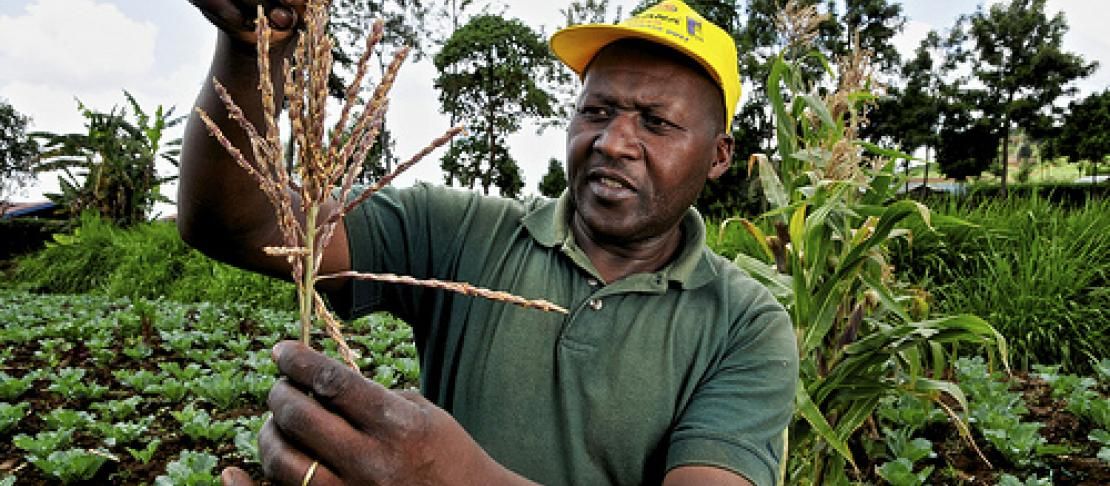Celebrating creative and innovative farmers from around East Africa

by Vivian Atakos, Catherine Mungai and Maren Radeny
“My hybrid beehive is cheap to construct and has produced 25 kilograms of honey, which I sold for 500 Kenya shillings per kg. This helped to sustain my family when my crops failed,” said Jack Olwendo at the recently held East Africa Farmer Innovation Fair (EAFIF). He managed to create quite a stir during the event with his innovative hybrid beehive.
Jack showed farmers, policy makers and development workers how he had been able to combine the Kenya Top Bar Hive with the Langstroth beehive to find a cost effective hybrid solution. "Langstroth beehives are quite costly and unaffordable to most farmers while the Kenya Top Bar beehives are cumbersome, as honey is harvested a little at a time," he explained willingly to his gathered audience. "This is not attractive to a commercial beekeeper who wants to maximize profits by minimizing time spent in harvesting."
Watch the above video to learn more about Jack's innovation and how it can help other farmers create resilience to climate change while improving incomes.
Several innovators had joined the fair activities, as many had been invited to share innovations under the following four categories:
• Crop production,
• Livestock production,
• Soil and water management and marketing,
• Technology and social innovations.
Who was the most innovative?
In the end, Gerald Kibugi from Kenya was crowned overall male winner for his innovative thinking on greenhouses for farmers, while Yebeyere Assefa from Ethiopia received the female winner award.
Gerald has created an information sharing software dubbed ‘Green House Do it yourself (DIY)’ which can guide farmers interested in green house farming to monitor their crops. “Farmers do not have the time to read and apply the lessons learned from available volumes of books on greenhouse farming", he said, "which is why I developed this software." "Now farmers can easily refer to this program whenever they want clarification on issues related to greenhouse farming," he continued. This simple technological application will increase farmers’ knowledge on greenhouse farming thereby enable them produce more food and achieve food security in the face of climate change.
Yebeyere Assefa on the other hand has come up with a ‘Three pot innovation’ that allows people working in the kitchen to prepare three different meals at the same time thereby contributing to energy conservation by rural households, who mostly use firewood for fuel. Her technology has spread among rural households in Ethiopia.
“Farmer fields are the real research laboratories that matter and stretch technologies from formal research institutions further, better and in a more adaptable way,” said Bell Okello, chair of Promoting Local Innovation in ecologically oriented agriculture and natural resource management (PROLINOVVA), Kenya who co-organized the EAFIF together with the CGIAR Research Program on Climate Change, Agriculture and Food Security (CCAFS) and other partners.
The event highlighted the importance of farmer innovations in agricultural development, and brought policymakers and the general public in Kenya in contact with farmer innovators.
The specific objectives of the fair were to:
•Raise awareness and share information about how smallholder farmers are innovating
•Encourage and disseminate innovations by smallholder farmers
•Identify and draw attention to more endogenous innovations than are currently known
•Influence policy to promote smallholder farmer innovation.
Crop production
Under crop production, Simon Musila’s finger millet innovation in a nursery bed bagged the top prize. “Millet, though popular has been disappearing on farms due to the labor intensive nature of growing the crop and unreliable rainfall,” notes Simon Musila. He has therefore developed a system of planting finger millet through seedlings grown in a nursery.
Simon has tested the crop on his farm, and attests that finger millet grown in a nursery bed then transplanted, gives higher returns compared to that grown using the traditional broadcasting method used by many farmers in East Africa. He therefore intends to share his discovery with other farmers, so that they can also benefit by increased income levels. Simon was also one of the smallholder farmers from Kenya who attended the Hunger, Nutrition and climate justice conference in Dublin Ireland in April 2013, where, he contributed to the learning circle on knowledge.

“I have learned a lot from other farmers. Most important, this event has brought me closer to partners who can help me improve and share my innovation,” said beehive innovator Jack Olwendo at the end of the event.
“Based on the success of this event, we plan to make it an annual thing. We intend to bring in other actors including the private sector and micro-finance institutions who can provide funding opportunities to take farmer innovations to the next level. We hope to involve the public on a larger scale” concluded Mr Okello.
Watch more photos from the fair:
This story was put together by Vivian Atakos, Catherine Mungai and Maren Radeny from the CCAFS East Africa Regional Office. Get the latest updates from the region by following CCAFS East Africa on Twitter: Cgiarclimate_ea.

